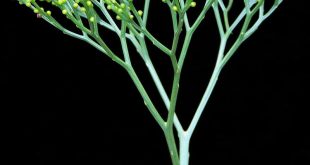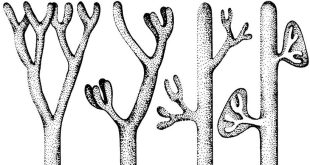Equisetum: The Scouring Rushes Equisetum commonly known as ‘Horsetails’ or ‘Scouring rushes’. It comprises about 25 species and is worldwide in distribution. Except This genus in vascular plants, there is no living genus in Equisetaceae family that reproduces by spores rather than seeds. Taxonomic position: Division: Sphenophyta Class: Sphenopsida Order: …
Read More »Lycopodium: The Creeping Pines
Systematic Position Division: Lycophyta / Lepidophyta Class: Eligulopsida Order: Lycopodiales Family: Lycopodiaceae Genus: Lycopodium Also known as club mosses, Lycopods, creeping pines or tailing pines. Ligule: A membranous outgrowth projecting from the leaf sheath. On the basis of ligule, Lycophyta has 2 classes: Eligulopsida: Lycopodium phylloglossum Liqulopsida – Isoetales, Selaginellales …
Read More »Psilotum: The Whisk Fern
Psilotum is commonly known as Whisk-fern. Salient features of Pilotum The sporophytes are dichotomously branched with an underground rhizome and upright branches. The upright branches are leafless. Rhizoids are present instead of root. Stem has a relatively simple vascular cylinder. The sporangia are born in groups (trilocular) and form synangia. …
Read More »Pteridophytes: Types of Stele & Its Evolution
A stele is the central cylinder or core of vascular tissue in higher plants and Pteridophytes. It consists of the xylem, phloem, pericycle, medullary rays, and pith if present. The term stele has been derived from a Greek word meaning rod or column. Van Tieghem and Douliot (1886) introduced this …
Read More »Pteridophytes: Classification of Pteridophyta
The term Pteridophyta was first coined by Haeckel. Eichler (1883) divided the plant kingdom into Cryptogamia and Phanerogamia. The Cryptogamia was further divided into Thallophyta. Bryophyta and Pteridophyta. Engler (1909) included the Bryophyta and Pteridophyta under Embryophyta. Due to discovery of the fossil plants, the classification of Pteridophytes has undergone …
Read More »Pteridophytes: Origin and Evolution
They are the earliest known vascular plants that originated in the Silurian period (400 million years ago) of the Palaeozoic Era and subsequently diversified and formed the dominant vegetation on earth during Devonian to Permian period. There are controversies regarding their origin and evolution. There are two broad theories about …
Read More »Evolution of Plants: Telome Theory
Telome theory was proposed by Walter Zimmerman (1952, 1965). This theory is based on fossil records and explains the major steps in the evolution of vascular plants. According to this theory, all vascular plants have evolved from simple, leaf-less, root-less and dichotomously branched sterile and fertile axes called telomes which …
Read More » Plantlet The Blogging Platform of Department of Botany, University of Dhaka
Plantlet The Blogging Platform of Department of Botany, University of Dhaka






